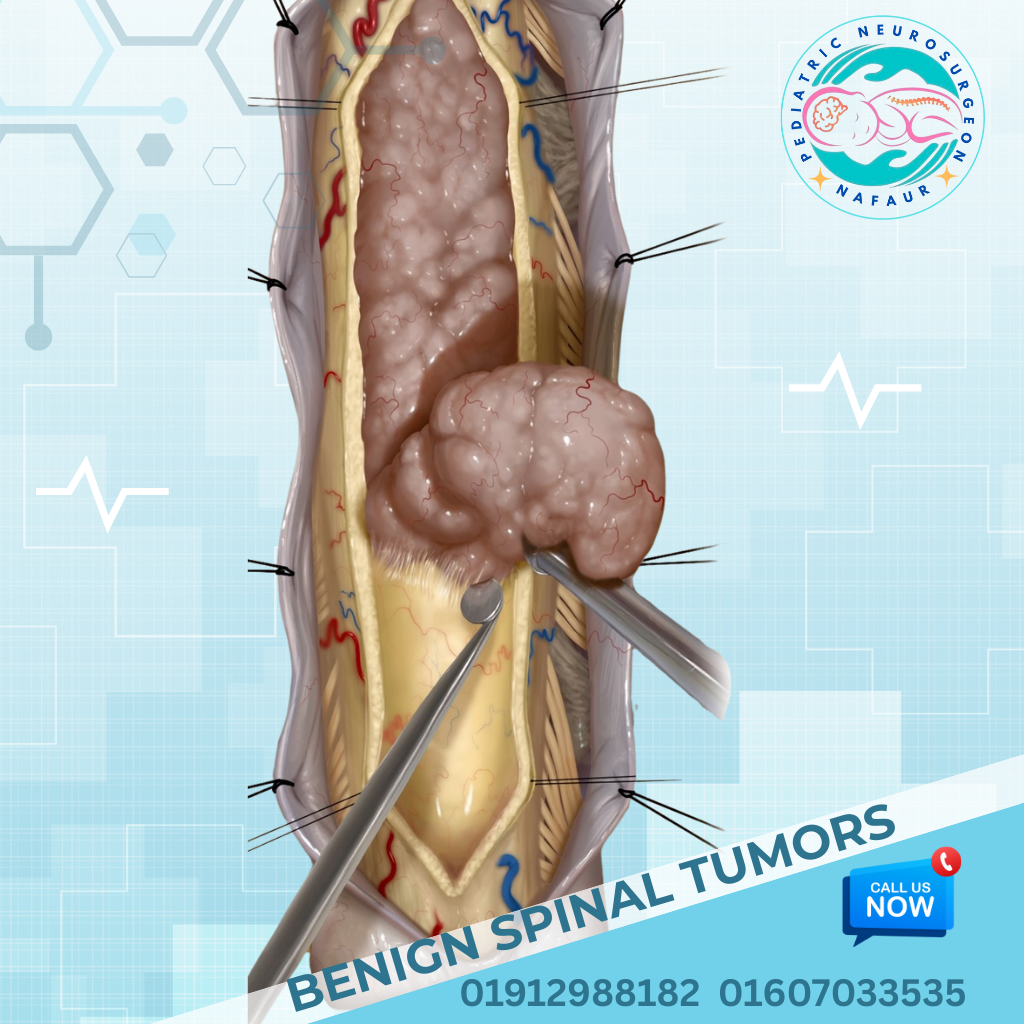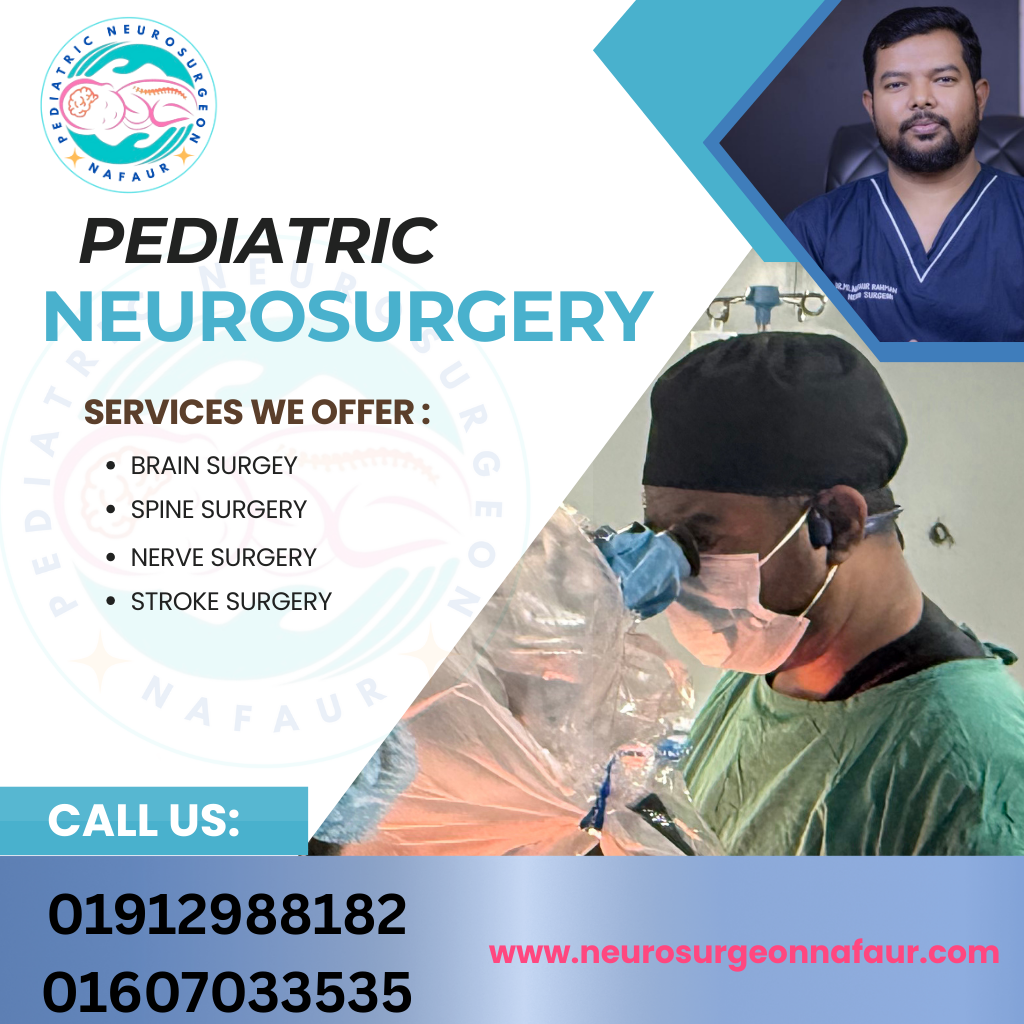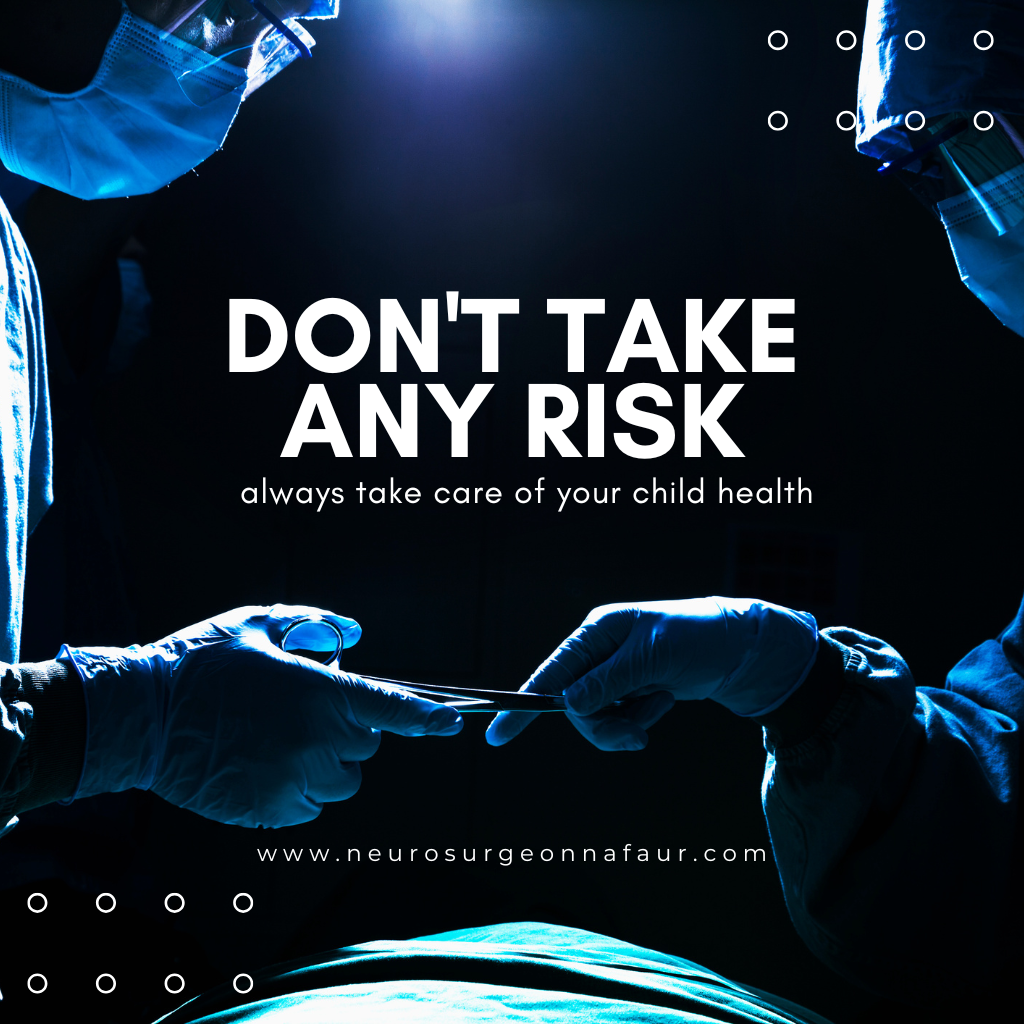Benign Spinal Tumors
Benign spinal tumors are non-cancerous growths that develop along the spine or spinal cord. Although they are not malignant, their location within or near critical neurological structures can lead to serious complications, including pain, neurological deficits, spinal deformity, and paralysis if left untreated.
In the context of Bangladesh, many children with spinal tumors remain undiagnosed or improperly treated, largely due to lack of access to pediatric neurosurgical services and delayed neuroimaging. Fortunately, with rising awareness and modern neurosurgical facilities at NINS and Bangladesh Paediatric Neurocare Centre, many such conditions are now being treated effectively under the leadership of Dr. Md. Nafaur Rahman.
 Common Types of Benign Spinal Tumors in Children
Benign spinal tumors can occur in various locations:
Intradural-Extramedullary: Outside the spinal cord but inside the dura
Intramedullary: Within the spinal cord itself
Extradural: Outside the dura, often involving bone
Most common benign spinal tumors in children:
Lipomas – Fat-containing tumors that may be associated with spinal dysraphism
Dermoid and Epidermoid Cysts – Often congenital, located near the lower spine
Arachnoid Cysts – CSF-filled sacs that may compress the spinal cord
Spinal Meningiomas – Rare but possible, especially in neurofibromatosis patients
Neurofibromas and Schwannomas – Nerve sheath tumors often associated with NF1
Osteoid Osteoma and Osteoblastoma – Benign bone tumors that can cause scoliosis and pain
Eosinophilic Granuloma (Langerhans Cell Histiocytosis) – Can affect vertebral bodies in children
Gangliogliomas and Pilocytic Astrocytomas – Intramedullary benign tumors
Each of these tumors may behave differently but can result in progressive neurological compromise if not detected early.
Common Types of Benign Spinal Tumors in Children
Benign spinal tumors can occur in various locations:
Intradural-Extramedullary: Outside the spinal cord but inside the dura
Intramedullary: Within the spinal cord itself
Extradural: Outside the dura, often involving bone
Most common benign spinal tumors in children:
Lipomas – Fat-containing tumors that may be associated with spinal dysraphism
Dermoid and Epidermoid Cysts – Often congenital, located near the lower spine
Arachnoid Cysts – CSF-filled sacs that may compress the spinal cord
Spinal Meningiomas – Rare but possible, especially in neurofibromatosis patients
Neurofibromas and Schwannomas – Nerve sheath tumors often associated with NF1
Osteoid Osteoma and Osteoblastoma – Benign bone tumors that can cause scoliosis and pain
Eosinophilic Granuloma (Langerhans Cell Histiocytosis) – Can affect vertebral bodies in children
Gangliogliomas and Pilocytic Astrocytomas – Intramedullary benign tumors
Each of these tumors may behave differently but can result in progressive neurological compromise if not detected early.
 Symptoms of Benign Spinal Tumors in Children
The symptoms vary based on tumor type and location, but early signs can be subtle and often overlooked:
Back pain, especially persistent or worsening at night
Scoliosis or abnormal spinal curvature
Limping, unsteady gait, or frequent falls
Weakness in arms or legs
Loss of bladder or bowel control
Numbness or tingling in limbs
Delayed milestones or walking difficulties in toddlers
Visible swelling or lump on the back (in superficial tumors)
In Bangladesh, such symptoms are often attributed to general weakness, vitamin deficiencies, or orthopedic issues, delaying proper neurological evaluation.
Symptoms of Benign Spinal Tumors in Children
The symptoms vary based on tumor type and location, but early signs can be subtle and often overlooked:
Back pain, especially persistent or worsening at night
Scoliosis or abnormal spinal curvature
Limping, unsteady gait, or frequent falls
Weakness in arms or legs
Loss of bladder or bowel control
Numbness or tingling in limbs
Delayed milestones or walking difficulties in toddlers
Visible swelling or lump on the back (in superficial tumors)
In Bangladesh, such symptoms are often attributed to general weakness, vitamin deficiencies, or orthopedic issues, delaying proper neurological evaluation.
 Diagnostic Work-up
Early and accurate diagnosis is essential to prevent permanent neurological damage. At Dr. Nafaur Rahman’s center, a structured diagnostic approach is followed:
Investigations Include:
MRI of the Spine with Contrast – The gold standard for detecting tumor type, size, location, and cord involvement
CT Scan – Useful for tumors involving bone (e.g., osteoid osteoma)
X-ray Spine – Can show scoliosis or bone destruction
Whole Spine Imaging – Important for multifocal or syndromic tumors (e.g., NF1)
Tumor Markers and Biopsy – In selected cases
Neurophysiological Tests – Pre- and post-operative assessment of motor and sensory function
Diagnostic Work-up
Early and accurate diagnosis is essential to prevent permanent neurological damage. At Dr. Nafaur Rahman’s center, a structured diagnostic approach is followed:
Investigations Include:
MRI of the Spine with Contrast – The gold standard for detecting tumor type, size, location, and cord involvement
CT Scan – Useful for tumors involving bone (e.g., osteoid osteoma)
X-ray Spine – Can show scoliosis or bone destruction
Whole Spine Imaging – Important for multifocal or syndromic tumors (e.g., NF1)
Tumor Markers and Biopsy – In selected cases
Neurophysiological Tests – Pre- and post-operative assessment of motor and sensory function
 Surgical Treatment of Pediatric Benign Spinal Tumors
While some tumors can be monitored, surgical excision is often necessary to relieve spinal cord compression and prevent long-term disability. Dr. Md. Nafaur Rahman specializes in precision microsurgery and child-safe spinal procedures.
Surgical Objectives:
Total or subtotal tumor resection
Spinal cord decompression
Preservation of neurological function
Spinal stabilization, if necessary
Minimally invasive techniques, whenever feasible
Common Procedures:
Laminectomy or Laminoplasty – To access and remove the tumor
Microsurgical tumor dissection – Under high magnification to protect nerves
Endoscopic-assisted removal – For selected cystic lesions
Spinal instrumentation – In cases involving bone tumors or instability
Tethered cord release – If associated with lipomas or dermoid cysts
“The success of pediatric spinal tumor surgery lies in balancing tumor removal with functional preservation. We follow global protocols while addressing each child's unique spinal anatomy.”
— Dr. Md. Nafaur Rahman
Surgical Treatment of Pediatric Benign Spinal Tumors
While some tumors can be monitored, surgical excision is often necessary to relieve spinal cord compression and prevent long-term disability. Dr. Md. Nafaur Rahman specializes in precision microsurgery and child-safe spinal procedures.
Surgical Objectives:
Total or subtotal tumor resection
Spinal cord decompression
Preservation of neurological function
Spinal stabilization, if necessary
Minimally invasive techniques, whenever feasible
Common Procedures:
Laminectomy or Laminoplasty – To access and remove the tumor
Microsurgical tumor dissection – Under high magnification to protect nerves
Endoscopic-assisted removal – For selected cystic lesions
Spinal instrumentation – In cases involving bone tumors or instability
Tethered cord release – If associated with lipomas or dermoid cysts
“The success of pediatric spinal tumor surgery lies in balancing tumor removal with functional preservation. We follow global protocols while addressing each child's unique spinal anatomy.”
— Dr. Md. Nafaur Rahman
 Postoperative Care & Long-Term Management
ICU monitoring immediately post-surgery
Early mobilization with physiotherapy
Bladder and bowel training, if required
Regular follow-up MRI scans
Rehabilitation and neurodevelopmental support
Coordination with pediatric oncologists for rare cases needing adjuvant therapy
Postoperative Care & Long-Term Management
ICU monitoring immediately post-surgery
Early mobilization with physiotherapy
Bladder and bowel training, if required
Regular follow-up MRI scans
Rehabilitation and neurodevelopmental support
Coordination with pediatric oncologists for rare cases needing adjuvant therapy
 Pediatric Spinal Tumors in Bangladesh – Bridging the Gap
The major obstacles in managing benign spinal tumors in Bangladesh include:
Delayed diagnosis due to low awareness
Limited access to pediatric MRI in rural regions
Lack of pediatric neurosurgery expertise in many districts
Sociocultural stigma about spinal surgery in children
Dr. Md. Nafaur Rahman addresses these issues by:
Providing free consultations in outreach clinics
Conducting training for general physicians and orthopedists
Performing safe and effective spinal surgeries in children using advanced tools
Offering cost-effective follow-up packages for long-term care
Pediatric Spinal Tumors in Bangladesh – Bridging the Gap
The major obstacles in managing benign spinal tumors in Bangladesh include:
Delayed diagnosis due to low awareness
Limited access to pediatric MRI in rural regions
Lack of pediatric neurosurgery expertise in many districts
Sociocultural stigma about spinal surgery in children
Dr. Md. Nafaur Rahman addresses these issues by:
Providing free consultations in outreach clinics
Conducting training for general physicians and orthopedists
Performing safe and effective spinal surgeries in children using advanced tools
Offering cost-effective follow-up packages for long-term care
 Why Choose Dr. Md. Nafaur Rahman?
Why Choose Dr. Md. Nafaur Rahman?
 Pioneer in pediatric spinal tumor surgery in Bangladesh
Pioneer in pediatric spinal tumor surgery in Bangladesh
 Based at NINS, the country's leading neurosurgical hospital
Based at NINS, the country's leading neurosurgical hospital
 Known for accurate diagnosis and evidence-based management
Known for accurate diagnosis and evidence-based management
 Excellent outcomes in spinal cord tumor removal and deformity correction
Excellent outcomes in spinal cord tumor removal and deformity correction
 Combines neurosurgery, neuro-oncology, and spinal orthopedics under one roof
Combines neurosurgery, neuro-oncology, and spinal orthopedics under one roof
 Contact for Pediatric Spinal Tumor Consultation
Dr. Md. Nafaur Rahman
Assistant Professor, Pediatric Neurosurgery, NINS
Chief Consultant, Bangladesh Paediatric Neurocare Centre
Contact for Pediatric Spinal Tumor Consultation
Dr. Md. Nafaur Rahman
Assistant Professor, Pediatric Neurosurgery, NINS
Chief Consultant, Bangladesh Paediatric Neurocare Centre
 For Serial/Appointment: 01912988182 | 01607033535
For Serial/Appointment: 01912988182 | 01607033535
 Website: www.neurosurgeonnafaur.com
Website: www.neurosurgeonnafaur.com

























